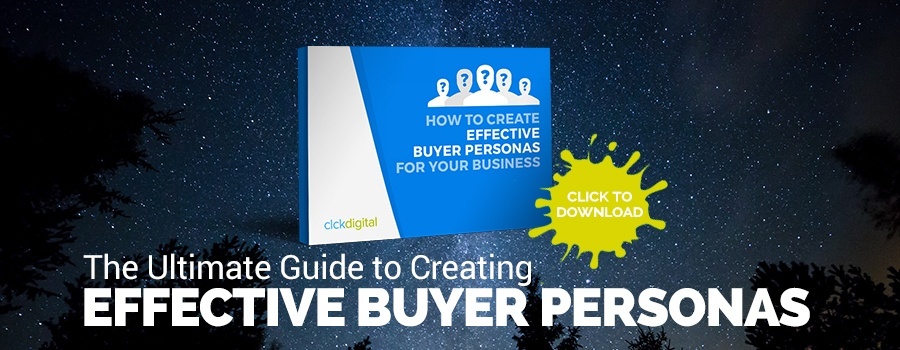In today’s marketing world, targeted content is vital: companies that want to attract as many potential customers as possible must be sure that they can identify the needs of each specific type of prospective buyer.
When referred to collectively, these different types of customers are known as buyer personas.
A buyer persona is a representation of your ideal customer. Developing buyer personas is an integral part of content marketing. Until you have a good idea for whom you are creating content, it’s much more difficult to create relevant, meaningful pieces of content that will connect with your ideal customers.
A buyer persona is also a description of the attributes of an entire segment of customers, consolidated into a single person. Frequently, this persona is given a common name based on their title. For example, “Medical Manager Mark” or “CEO Charlie,” could be two of your buyer personas.
Now let’s look at buyer personas in more detail.
Why create buyer personas?
 The main reason to create buyer personas is because they help you keep your customer in mind when creating content. A buyer persona makes it easier for your marketing to answer the questions that your real prospective customers are asking, which means your content will hold more value for them.
The main reason to create buyer personas is because they help you keep your customer in mind when creating content. A buyer persona makes it easier for your marketing to answer the questions that your real prospective customers are asking, which means your content will hold more value for them.
Marketing research backs up the benefits of using buyer personas: according to data from research firms DemandGen and Forrester, using buyer personas in an email campaign can double your campaign’s open rate and increase your click through rate five-fold.
Even if you already understand the benefits of creating buyer personas, it’s still important that you include the right elements in your personas.
How Many Buyer Personas Do I Need?
Many people assume that they need to have several buyer personas, which can be daunting when first getting started. The truth is, however, that most businesses will have between one and three buyer personas.
The number of buyer personas required will depend on how many distinct groups make up your target market.
For example, here at CLCK Digital, we have three buyer personas: Victor the Marketing Manager, Sam the Business Owner, and Agency Annie. Agency Annie is not strictly part of our target audience, but it’s helpful to have a category for people who may be competitors (see Negative Buyer Personas below), or someone you may be able to target content at in the future if you expand your service offering.

If you’re completely new to buyer personas then consider just creating one main persona, then expand it out into two or three when you get comfortable with the process.
What to Include in Buyer Personas
 Every marketer will have a slightly different approach to creating buyer personas, however, there are a few common elements that should be included for a buyer persona to be as effective as possible.
Every marketer will have a slightly different approach to creating buyer personas, however, there are a few common elements that should be included for a buyer persona to be as effective as possible.
- Role or job title – This attribute defines what type of position the persona holds in their company, whether they are the owner, a mid-level manager, or a marketing professional. For B2C companies, this area may be replaced with information about the consumer’s background and beliefs
- Challenges – What are the problems that this buyer persona commonly faces? More specifically, this is where you talk about the challenges that your buyer persona is dealing with that can be resolved by the products or services that your company offers
- Consumption of information – This part of your buyer persona determines how your prospects find out what they need to know in order to stay current on the news stories and developments that are important to them. For example, does your persona read the newspaper or check their favourite blogs to find out about news stories? Are they more likely to call a friend on the phone, or send them a text message to find out what is happening with them?
The specific components of your buyer persona may vary depending on your industry and the type of products or services that you offer. Some companies will provide you with tips and templates to help you create a buyer persona, but at the end of the day your company is the one that is responsible for making sure that your personas are as accurate as possible.
Besides the consideration of what specific information to put in a buyer persona, the other most important concern to address when it comes to buyer personas is how you will research to get accurate information to incorporate into your buyer personas.
Researching for Buyer Personas
 The easiest and most immediate source of information for your buyer personas should be your existing customer base. Think about the different types of customers that you have and see if you can answer the questions that need to be asked during the creation of a buyer persona based on what you already know about these customers. If not, you might consider creating a survey to get information about your current customer base that can help you complete your buyer personas.
The easiest and most immediate source of information for your buyer personas should be your existing customer base. Think about the different types of customers that you have and see if you can answer the questions that need to be asked during the creation of a buyer persona based on what you already know about these customers. If not, you might consider creating a survey to get information about your current customer base that can help you complete your buyer personas.
You can also use information from prominent research and business consulting companies to aid in the creation of your buyer personas. Authoritative research sources for customer data include Nielsen, Forrester, and Deloitte. Take your time with your research and make sure you have a sufficient persona outline in place before you attempt to research in earnest: otherwise, it will be tough for you to find the information that is pertinent to your buyer personas.
Yet another way to provide the all important background research that goes into creating a buyer persona is to ask the people who spend the most time dealing with your existing prospects or customers. Usually this will be your sales team. Ask them what questions they get asked the most so you can figure out your buyer persona’s main problems, challenges, and possible objections.
So how do buyer personas translate into real world results?
Let’s look at a practical example of how buyer personas can make you a more effective marketer.
Say you have three different buyer personas for your business. Whenever you embed a form on your site, whether that form is a contact form or a form for downloading a free resource, you can have a drop-down field in that form that asks the visitor a question such as “Best describes you…”. You then give the three options that match each of your buyer personas. For example, say your business sells software products to hospitals. Your drop-down options might be:
- I am the CIO of a hospital
- I work in the IT department of a hospital
- I am a consultant to hospital IT departments
Of course, this is just one of several fields in your form, which will also ask for the person’s name, email address, etc.
Then, based on the drop down option the visitor chooses from the above list, you can put the person into their own “bucket”. So, you could set up a separate email lead nurturing sequence for each of these groups. The CIO would receive a series of emails explaining how to save time  when evaluating hospital software (based on your persona research that a CIO’s main challenge is having enough time to evaluate options). You might have a different follow up sequence for the IT worker that focuses on how to get buy-in from their superiors when trying to implement a new software system.
when evaluating hospital software (based on your persona research that a CIO’s main challenge is having enough time to evaluate options). You might have a different follow up sequence for the IT worker that focuses on how to get buy-in from their superiors when trying to implement a new software system.
See how powerful buyer personas can be? They aren’t just abstract concepts that exist for the sake of theory. They can help streamline and focus your marketing automation in ways that aren’t possible without the detailed information that a buyer persona embodies.
Negative Buyer Personas
It’s important to also have negative buyer personas. A negative buyer persona is a profile of a person that may be drawn to your content, but with whom you don’t want to work. Examples of negative buyer personas might be:
- Competitors
- Students
- People who don’t have the budget for your services
- People outside of the geographic area you’re targeting
While all of these groups may be consuming your content, you don’t want them cluttering up your marketing funnel because they’re never going to become customers. So you might include some questions on your forms (such as “what is your annual turnover”) that help you identify these groups and then move them to a separate “backburner” list.
For example, you might still have them on your general updates list and they’ll be notified when you publish new blog articles, but they won’t receive email follow up sequences encouraging them to move closer to a sales conversation with you.
Negative buyer personas don’t need to be as detailed as your buyer personas because you’re not trying to connect with these people. It helps to classify them into distinct groups (competitor, student, etc.) so that if your (or their) circumstances change in the future they could become marketing leads.
I Created Buyer Personas, Now What?
 Once you have your personas in place, you can use them as effectively as possible by choosing specific personas to target with your content marketing strategy. For example, you might choose to run one blog post per week targeted at each buyer persona that your company has created.
Once you have your personas in place, you can use them as effectively as possible by choosing specific personas to target with your content marketing strategy. For example, you might choose to run one blog post per week targeted at each buyer persona that your company has created.
It is also very important that you consider your buyer personas in email marketing. Market research shows that the more segmented your email marketing recipient list is, the more likely it is that these recipients will open your email. In a 2013 metrics report, email marketing company Vision6 reported that as email marketing send volumes increased, open rates went down.
This means that the more people you send a specific piece of email marketing to, the more likely it is that your email will go unopened. By segmenting your email list based on your buyer personas, you can reduce the number of recipients for each unique piece of email marketing, to make it more likely that your prospects will open and look through the correspondence that you send them.
Although this post provides a good overview of buyer personas and why they are important, there is plenty more for you to know about them.

- How Videos Can Be Used in Email Marketing for More Engagement - April 4, 2022
- Attention Home Builders: Here’s How to Educate, Engage and Win Over Potential Customers - October 19, 2020
- The Best Digital Marketing Framework for High Ticket Businesses - September 14, 2020

